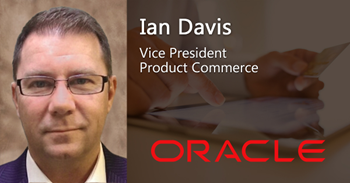Gartner Magic Quadrant for Digital Commerce 2019 Review
CMS-Connected Media Corp. is proud to bring you special coverage of the Gartner Magic Quadrant for Digital Commerce 2019. As with our other Gartner reviews, our write-ups feature exclusive interviews with and comments directly from the vendors represented in the Gartner MQ. This year’s digital commerce Gartner matrix is ‘slightly less blue,’ given that it contains four fewer vendors than it did the previous year. Our coverage examines the vendors, their strengths and cautions, and makes sense of the movement of those dots within the borders the Gartner quadrant.
Click our link to receive a free copy of the Gartner Magic Quadrant for Digital Commerce 2019.
Gartner considers a digital commerce platform to be “the core technology enabling customers to purchase goods and services through an interactive and self-service experience.” They add that a digital commerce platform should provide “necessary information for customers to make their buy decisions, and uses rules and data to present fully priced orders for payment.”
This year’s Magic Quadrant for digital commerce systems was authored by Gartner's Penny Gillespie, Christina Klock, Mike Lowndes, Sandy Shen, Jason Daigler, and Yanna Dharmasthira. The report’s central aim is to inform and guide business leaders in selecting a digital commerce platform relying on Gartner’s careful evaluation and judgments of the selected digital commerce vendor’s strengths and cautions. Gartner maintains that the platform should have “out-of-the-box” capabilities or self-service supporting APIs, providing an experience with features such as:
Gartner classifies the vendors into four different quadrants as follows:
Leaders
These vendors have B2C and B2C commerce functionalities across a wide range of industries and business models. They have a strong sales and support system, whether direct or through partners, and can easily support and can handle large “transaction volumes and high levels of digital commerce GMV revenue.” Thanks to their constant innovation and functionality additions, they set the bar for all vendors in the industry.
Challengers
Typically, vendors in this category have a narrower focus when it comes to industries and markets they serve. Highly respected, they aren’t afraid to invest in new technologies and innovate in order to grow themselves or their customer list.
Visionaries
Vendors in this category are much like the name suggests, visionaries. They like to innovate and disrupt and often find ways to incorporate new technologies into their platforms. They tend to lack the resources larger competitors possess and have smaller partner networks, but they move fast and often serve a niche market with unaddressed needs.
Niche Players
The Niche Players typically provide cost-effective solutions and cater to target markets that are often small or emerging. They have a limited geographical presence, a narrower product and service offerings, and small range of partners.
| 2018 Gartner Magic Quadrant for Digital Commerce |
2019 Gartner Magic Quadrant for Digital Commerce |
|
|
|
Click images above to enlarge |
Leaders (Adobe-Magento, Oracle, SAP, and Salesforce)
Adobe-Magento
Holding its place as leader for the third year in a row is Magento Commerce — acquired by Adobe in June 2018. Catering to both SMBs with Magento Commerce, or enterprise customers with the Magento-Commerce-based Adobe Commerce Cloud, the company, gets praise for their native WCM builder and application and partner ecosystem. The report indicated that their SaaS offerings, B2B functionality, and Adobe-Magento integration could use improvement.
Interviewee: Peter Sheldon, Senior Director, Strategy
Once again, you’ve been named as a Leader in this year’s edition of the Gartner MQ Digital Commerce Report. What is Adobe’s (Magneto) doing to continue earning this position?
"We’re heavily investing in innovation. Through the combination of our own product development and the growing community of partners and developers - who also contribute to our roadmap - we are outpacing all of our competitors in the delivery of new innovations for Adobe (Magento) brands and merchants. Recent examples include our first-to-market delivery of Progress Web Apps (PWA’s); a full headless architecture using GraphQL; expansion of our cloud infrastructure to support both Microsoft Azure and Amazon Web Services; and most recently, investment in Product Recommendations for Magento Commerce powered by Adobe Sensei – our AI and machine learning technology."
What makes the Adobe’s (Magento) platform stand out from the other vendors in this Quadrant?
"Our whole DNA is focused on experiences, and as merchants realize that today’s shopping experience is all about providing customers with bespoke experiences that fit their shopping needs, they’re really seeing the benefit of partnering with a company like Adobe. Our growth in the market is outpacing all of our competitors. In the enterprise segment, we’ve seen tremendous growth in both our pipeline of opportunities and closed deals since the Magento acquisition. Our release of Adobe Commerce Cloud is enabling our enterprise-sized customers to realize their vision of building commerce journeys that are experience-led rather than product-focused. In the mid-market, we’re also seeing remarkable growth especially among B2B manufacturers, distributors and wholesalers who are attracted to Magento’s flexibility, broad eco-system of industry-focused partners and attractive cost of ownership."
How do you plan on addressing the ‘Cautions’ the report has mentioned?
"In regard to our cloud offering, we’re already in Beta for enabling multi cloud infrastructure on both Microsoft Azure and Amazon Web Services. Furthermore, we’re also in Beta for providing auto-scaling of the infrastructure. We will be making both of these capabilities generally available for all of Magento’s cloud customers in 2020. In relation to our B2B capabilities, we recently announced the acquisition of a comprehensive approvals and workflow module natively developed for Magento by one of our solution integration partners. Integration of this capability is already underway and is targeted for general availability sometime next year."
What future plans are on the horizon for Adobe’s (Magento) digital commerce offerings?
"Next year, we’ll be focused on completing the rollout of our GraphQL API’s to cover 100% of the services in Magento, enabling full headless deployments of Magento with custom front-end experience architectures. We will further invest in bringing AI driven capabilities to the platform to drive merchant operational efficiencies across marketing, merchandising and fulfillment as well as bring more personalized and engaging experiences to bare for the shopper."
Oracle
It is no surprise to continue to see Oracle in the Leader corner once again, given their strong product offering and technology. The leading vendor has two main solutions: Oracle Commerce, serving B2B, B2C, and B2B2C clients in the $250M-$1B GMV range, and Oracle Commerce Cloud serving B2B and B2C in the $50M-$1B GMV range. Oracle’s strengths include their breadth of product offerings, enhanced features in their Oracle Commerce Cloud, and a “rich set of RESTful APIs.” The vendor’s ‘cautions’ included their lower number in the Commerce Cloud customer availability, their product integrations, and confusing migration path.
Interviewee: Ian Davis, VP of Product Commerce, Oracle CX Commerce
Oracle has again been named as a Leader in this year’s edition of the Gartner MQ Digital Commerce Report. What is Oracle doing to continue earning this position?
"Oracle CX Commerce has been named a Leader in this space for the last ten consecutive evaluations. We’ve been building scalable commerce platforms for over 20 years, and we’ve partnered with companies of all sizes and at various stages of their commerce maturity. During that time, we’ve seen the industry evolve dramatically as well. With each shift, we’ve evolved our platform to make sure companies have what they need to keep their competitive edge. Oracle CX has been consistently focused on creating highly agile, consumable, and customizable solutions for our customers. We have been creating everything with a backward-compatible way that allows Oracle to deliver more features consistently so customers can easily adopt without adding risk."
What makes the Oracle platform stand out from the other vendors in this Quadrant?
"The report points to Oracle CX Commerce’s API utilization and ability to operate fully ‘headless’ as a strength by providing “a rich set of RESTful APIs, allowing clients to customize the applications to meet their needs.” For Oracle CX Commerce, these APIs are a differentiator when compared to other multitenant SaaS commerce platforms that only expose a subset of functionality via API. With Oracle CX Commerce, every function of the system is exposed via API, allowing customers to extend the platform and inject commerce into any touchpoint or application in a way that best fits their business. Additionally, speed to value, constant innovation, and agility are essential to compete in both B2B and B2C commerce. According to the Gartner findings, “reference customers scored Oracle above the aggregated average score of all vendors in this Magic Quadrant for its ability to deliver planned roadmap product enhancements quickly.”
How do you plan on addressing the ‘Cautions’ the report has mentioned?
"As the report states, Oracle continues to increase our number of signed contracts and implementations. It’s important to remember the platform has been in the market for four years. Four years is a relatively short time compared to many other platforms in the report. This gives our customers a huge opportunity and competitive advantage over their competitors. They have the ability to leverage a modern, cutting edge, open platform built on a foundation of one of the most battle-tested platforms running some of the biggest eCommerce sites today. It’s really the best of the worlds, and it’s just the beginning. We've launched nearly 400 sites in a fairly short amount of time across retail, fashion, CPG, manufacturing, telco, automotive, and other industries. We are a platform designed for companies looking to leapfrog their competition, not just run alongside them.
Every business is unique in how they function as well as the tech stacks supporting them, which is why integration is one of the biggest areas of an implementation where companies can trip up. However, we mitigate that risk in several ways. First of all, we’ve built numerous native integrations where it makes the most sense. For example, we provide native integration to order management.
However, native integrations don’t always make sense because there can’t be a one size fits all approach to integration. To provide customers with options, we expose everything via API and webhooks. This allows CX Commerce to plug into any integration framework seamlessly including Oracle Integration Cloud (OIC) via a productized adapter. OIC allows customers to create integrations designed for the way they do business with their unique tech stacks in a low code or no code fashion. There are over 70 adapters to common systems Oracle and non-Oracle along with prebuilt recipes or integration starting points. This approach is far more flexible and easier to maintain in the long run as a company's technology ecosystem and requirements change.
Just like integration is unique to every customer, so is migration. However, there is a migration path for everyone if they so choose. When customers choose to migrate, we offer best practice guides on how to transition from on-premise to the cloud and our partner ecosystem provides numerous data migration scripts to move data between systems. It’s far easier for customers to transition from on-premise to our cloud than to a competitor since there are so many similarities between the applications. In addition, cloud provides an opportunity to think differently for the next phase of a company’s commerce journey. It’s a nice blend of familiarity and reliability while providing a solution that is more modern, easier to use, and open."
What future plans are on the horizon for Oracle’s digital commerce offerings?
"Future releases will continue to help companies win in “the new normal.” A key component of this is supporting new business models, which is why we are integrating our CX Commerce solution closely with our Subscription service for B2B and B2C. Research shows consumers will pay more for novel experiences, so we continue to invest in AI-driven personalization with integration to CX Unity, Oracle’s customer intelligence platform, to create a more personalized and relevant storefront experience. But AI doesn’t stop at the storefront. We are investing in AI to provide a better experience for admin users of the application as well by providing them the right insights and suggestions to improve the experience. Think of it as Autonomous Merchandising. It’s a whole new level of efficiency when it comes to maintaining the site and growing the business."
SAP
Long-time leader SAP continues to hold on to their position thanks to their Commerce Cloud offering in the commerce space. Their product suite gets praised for being comprehensive, as does their overall commerce functionality and industry accelerators. SAP Commerce Cloud’s APIs and cloud extensibility frameworks continue to be a work in progress for the vendor, and the report cautions possible clients to thoroughly review their digital access policy.
Interviewee: Riad Hijal, Global Vice President, Commerce Strategy & Solution Management
Once again, SAP has been named as a Leader in this year’s edition of the Gartner MQ Digital Commerce Report. What is SAP doing to continue earning this position?
"SAP has invested significantly in the modernization and functional differentiation of SAP Commerce Cloud in the past 24 months. This position is the culmination of that focus and corresponding investment. SAP Commerce Cloud is now a fully cloud-native API-first commerce platform, allowing customers to benefit from capabilities such as native auto-scaling and embedded application performance monitoring to optimize daily operations and excel in customer experience. Using steam-AI, SAP Commerce Cloud enables businesses across geos, industries, and size to provide customers with individually relevant, in-the-moment experiences, seamlessly crossing channels, and connecting demand and supply chain. Its API-first micro services-based architecture provides businesses with the flexibility of both headless as well as “with a head” deployments, in order to deliver the agility and innovation required to gain longstanding competitive differentiation and advantage."
What makes the SAP platform stand out from the other vendors in this Quadrant?
"SAP Commerce Cloud is a modern and highly agile commerce platform, but unlike other less mature solutions in the market, this agility is not achieved at the expense of functional richness or our customers’ ability to differentiate their business. It offers the best of both worlds, providing a comprehensive set of rich AI-enabled out-of-the-box functionality while enabling business differentiation and innovation via a flexible microservices extension layer (SAP Cloud Platform Extension Factory), without affecting upgradability! It also provides a rich product content foundation (via SAP Product Content Hub) enabling a consistent product experience across over 1500 syndicated channels. SAP Commerce Cloud is infused with AI and automation across personalization, merchandising and product content, enabling business users to provide differentiated customer experiences efficiently seize business opportunities as they emerge. It is also the only solution in the market that includes a best of breed fully API-enabled commerce engine, a PIM (SAP Product Content Hub), a personalization engine (SAP Context-Driven Services), an OMS and a CMS all on a single and fully integrated cloud-native platform across B2C, B2B and B2B2C business models. SAP Commerce Cloud is also the only solution in the market that provides deep industry functionality above the traditional commerce industries (such as retail, CPG, and wholesale) with dedicated Financial, Public Sector, Utilities, Travel, and Telco capabilities and accelerators. Finally with the recent acquisition of Qualtrics, SAP is the only vendor that can tie in Experience (X data- the why) and Operational (O data – the what) Data seemingly across the customer journey to surface insights that allow businesses to compete in the experience economy."
How do you plan on addressing the ‘Cautions’ the report has mentioned?
"While the Gartner Commerce MQ was released in August 2019, the evaluation was based on the status of the solution as of December 2018. In the 10+ months since Gartner performed the evaluation, most of the cautions have been addressed in one way or the other. Specifically in July of this year, SAP released a Single Page Application (SPA) de-coupled javascript storefront (Spartacus), which is also progressive web app (PWA) enabled. This is the culmination of the API renovation effort mentioned above that has been ongoing for the last 24 months, enabling businesses to run SAP Commerce Cloud in either headless or “with-a-head” fashion. This, in turn, enables business to deliver rich, contextual and highly responsive experiences across devices and channels. Regarding the microservices extensibility and agility layer (SAP Cloud Platform Extension Factory), the solution is now in production in conjunction with SAP Commerce Cloud at multiple customers spanning various industries, geos, size, and business models, and the feedback from customers and partners so far has been overwhelmingly positive! Finally with regards to digital access, SAP as an organization has made significant strides in its digital access policy in the last few years and is constantly adapting said policies to reflect how our customers use SAP solutions in the digital age."
What future plans are on the horizon for SAP’s digital commerce offerings?
"SAP will continue doubling down on its innovation roadmap as it relates to Commerce Cloud! Stay on the lookout for even more out of the box native AI innovations, more agility with our API-first decoupled Spartacus storefront, more cloud-native services, additional end to end X+O scenarios with Qualtrics as well as continuous innovations in SAP Product Content Hub and SAP Context-Driven Services offerings."
Salesforce
The partner network and rich application ecosystem of Salesforce are just one of the many reasons it earned the label as Leader once again. Other strengths include their B2B capabilities and “strong” viability. The leading vendor offers two “distinct multi-tenant SaaS Commerce platforms with a B2B and a B2C solution.” The report does caution on the vendor’s headless commerce capabilities, lack of integration between the two commerce solution platforms, and overall integration with other Salesforce products.
Interviewee: Bobby Amezaga, Vice President, Product Marketing, Salesforce Commerce Cloud
Salesforce has been named as a Leader, once again, in this year’s edition of the Gartner MQ Digital Commerce Report. What is Salesforce doing to continue earning this position?
"Our success can be attributed to our customers. We’re always listening to and working closely with our customers to deliver the best solutions possible. From our founding 20 years ago, Salesforce has been laser-focused on bringing companies and customers together — we are unrelenting in our commitment to helping our customers scale and succeed faster than ever.
For Commerce Cloud specifically, we’ve been able to continue delivering a highly scalable, secure, intelligent, and flexible solution for our customers. With more than 4,200 live commerce sites, spanning more than 80 countries across the globe, the Commerce Cloud platform enables companies to drive revenue growth with personalization, native AI, and a spectrum of capabilities from click-based templates to code-based developer tools. So whether a small or mid-size business wants to launch sites fast that scale internationally, or an enterprise business wants to take a headless approach to create completely custom storefronts and apps, Commerce Cloud enables companies across every size and industry to deliver premium customer experiences at every stage of the shopper journey."
What makes the Salesforce platform stand out from the other vendors in this Quadrant?
"Salesforce Commerce Cloud is not only a complete B2B and B2C commerce platform, but it is also the only commerce platform that is natively integrated with the entire Salesforce platform — the global leader in CRM — enabling companies to seamlessly connect commerce to service, marketing, sales and more. Additionally, Commerce Cloud is bolstered by natively-built artificial intelligence with Einstein and a broad ecosystem of partners that enable companies to customize their eCommerce storefronts and apps to their unique business and customer needs and embed them across customer touchpoints, like Instagram or Alexa."
How do you plan on addressing the ‘Cautions’ the report has mentioned?
"We’re always listening to and working with our customers to evolve our product offerings across the board. We’ll continue this approach to make sure we’re delivering the best solution possible to make our customers successful in this ever-evolving world of technology."
What future plans are on the horizon for Salesforce’s digital commerce offerings?
"Salesforce will continue to lead the way in eCommerce with more than half a billion shoppers using Commerce Cloud every month. We recently announced a brand new product called Lightning Order Management, a modern, customer-first order management system designed for today’s eCommerce scale and experience needs."
Challengers (Episerver and Shopify)
Episerver
Designated as a challenger for the third year in a row, Episerver and its strengths include their “full-featured” platform, strong content and commerce capabilities, and ability to offer cost-effective solutions to its customers. Episerver currently supports B2C, B2B, and B2B2C capabilities with most customers from manufacturing, wholesale, and retail, as well as the distribution industry. The report indicated that Episerver needs to work on enhancing their enterprise offerings, headless approach, and “Microsoft centricity.” 
Interviewee: Ed Kennedy, Senior Director of Commerce Strategy
What tools, features, and functionality (architecture) do you think helped place Episerver in this category?
"To be a challenger, you must be able to execute (the Y-axis), Gartner has been impressed by our ability to execute. We facilitate over $18 billion in omnichannel revenue through our eCommerce, personalization, and email marketing solutions. We’re doing this on a global scale today, with thousands of websites running on our cloud platform and millions of visitors coming to our customers’ eCommerce websites every single month. In my opinion, this shows Gartner we’re not just a niche player in eCommerce but have serious volume and very high adoption of our platform."
What do you think differentiates you from your competitors?
"Gartner has always recognized the strength of our entire suite, not just commerce. They rate us highly in ability to execute because we deliver multiple solutions in one subscription than other vendors have to piece-meal together. Specifically, the fact that our eCommerce and CMS platforms are integrated into one application, other vendors either do not have a CMS, or it’s an entirely separate application that needs to be installed and integrated. The list goes on; product recommendations engine, site search, email marketing, A/B testing, need to be bought and integrated together with other vendors. Since we combine them, it costs less to purchase and integrate, making our solution more affordable. Gartner gives us high marks for that."
How does Episerver plan to address the ‘Cautions’ outlined in the report?
"Some of the cautions from Gartner were related to the segment of the market we address, citing that we have few customers over $250 million in online revenue. This is by design, as we focus on supporting fast-growing companies that are implementing their first- or second-generation eCommerce website and need to scale up to $200 million or more. We have several customers with over $600 million and our platform has proven to scale at very high page views per second and transactions per second. I don’t take offense to that critique.
The other caution regarding headless is interesting. We recommend our customers carefully evaluate if pure-headless is the answer for their business. Most companies have flocked to SaaS chasing the promise of ‘out of the box features’ and ‘automatic upgrades.’ Implementing pure headless puts your IT or systems’ integrator at the center of your digital experiences, and can slow an eCommerce team down significantly. I’m skeptical of vendors that are pushing small and mid-size organizations to ‘go headless.’ Larger corporations who have very mature technology culture and have a need to integrate features from three or more systems may need headless, but I think it’s a bit of a hype cycle right now. We do provide a headless API so that customers can use our platform in other modes. Buffalo Wild Wings uses our platform in their tablet displays in stores, and SRS Distribution uses a headless version of our platform to deliver their mobile app experiences. I’m much more favorable to ‘also-headless’ or ‘hybrid-headless’ approaches that keep the business user in the driver’s seat of their platform and don’t put technology on the critical path.
The last caution regarding Microsoft is interesting, as well. We made a strategic decision several years ago to adopt one public-cloud platform to build our software on Microsoft Azure. We chose to standardize because the deeper we went into one platform, the more features we could deliver to our customers such as CDN, App Insights, Azure Service Bus, and other features in the Microsoft Azure cloud platform. Other vendors who support multiple cloud deployment models are not going deep enough into each to provide rich features. They are selling licenses that can be deployed to these clouds by the software vendor. It is essentially managed services, not true software-as-a-service architecture. I’m proud of what our team has been able to deliver to our customers and partners. Now, Episerver customers can fully manage their environments in our Episerver Digital Experience Cloud portal including pushing their own deployments and managing their environments."
What future plans are on the horizon for Episerver’s digital commerce offerings?
"I’m most excited about how our platform is helping our customers to become more customer-centric. A lot of marketers see data points when they should see customers. They see clicks instead of behavior. They’ve dehumanized marketing and eCommerce which used to be very personal when we shopped in stores. To that end, Episerver is continuing to invest in our AI personalization suite, which will allow our merchandizers to automate many of their repetitive tasks, so they can get back to the important work of connecting with consumers, presenting relevant messaging and analyzing the big picture behavior of their website. Our most recent product, Episerver Insight is an analytics platform that helps customers to become more customer-centric. Google Analytics doesn’t track users across devices, Episerver Insight does. When we can look at one person’s journey between devices, we can detect patterns about their behavior and predict what, where and when they will come back next. Armed with this intelligence, our customers can then personalize the website experience to segments that are exhibiting similar behavior. I think analytics is where eCommerce platforms are going and need to arrive at, but not just session tracking. Analytics needs to deliver aggregated, unified journeys so eCommerce teams can see very clearly which channels, devices, content, and products are performing and respond accordingly."
Shopify
Shopify made a move into the Challenger corner from the Niche Player, in part due to the platform’s easy usabilities, attractive pricing, and comprehensive integration capabilities with many channels. The report cautions on Shopify’s functionality, particularly when it comes to B2B capabilities, lack of prebuilt back-end connectors, and a more concentrated North American market reach. CMS-Connected was unable to schedule an interview with Shopify in time for our article publication.
Visionaries (commercetools and Elastic Path)
commercetools
commercetools continues to be hold fast as a visionary in offering its cloud-native, multi-tenant SaaS services to both B2C and B2B customers — the latter supporting B2B2C capabilities and features such as a PIM tool and an open-source marketplace operations add-on module. The report praises commercetools for their partner ecosystem, speedy development, and consistently happy customers. The vendor’s geographical presence, however, is limited, as is their offering’s complexity.
Interviewee: Margaret Rea, VP, Head of America’s Marketing
commercetools has been named as a Visionary in this edition of the Gartner MQ Digital Commerce Report. What tools, features, and functionality (architecture) do you think helped place commercetools in this category?
"There are three key areas we believe helped place commercetools in the Magic Quadrant as a Visionary for the second year in a row. First, is our approach to cloud. We built our platform in the cloud vs. other platforms that are on the cloud. By being an integrated part of the cloud, developers can take advantage of all the cloud tools and interact easily with our platform. Second, is our extensibility model. From a development standpoint, customers can add attributes to the data model on the fly and inject serverless functions into our platform. These are examples of how easy it is for developers to build custom services around our platform to suit the needs of their business. Finally, customers can use commercetools a la carte meaning that unlike other platforms on the market that require the use of their entire platform like product catalog, customers and orders, with commercetools, customers can use pieces of the platform individually."
What do you think differentiates you from your competitors?
"We at commercetools built our platform from the ground up to give our customers a commerce platform technology of the kind you find in companies like Zalando, Amazon or Jet at the fraction of the costs compared to building that in-house. Our MACH architecture – which stands for Microservices, API-first, Cloud-native and Headless – are the four pillars of a modern commerce architecture that help companies gain speed and agility."
How does commercetools plan to address the ‘Cautions’ outlined in the report?
"The cautions outlined in the Magic Quadrant included global presence, vertical solutions and complexity. Recently – and before the research and publication of the Magic Quadrant – commercetools signed a $145M deal with Insight Partners to accelerate global growth. This investment will fuel growth in the APAC region where commercetools opened an office in June 2014 and recently signed its first major deal with a regional transportation brand. commerecetools has a growing presence in Latin America where we have signed major retail and B2B brands and are onboarding several large regional system integrator partners. In the area of vertical solutions, the commercetools platform is being used and deployed by large enterprises across a variety of verticals including telco, automotive, retail, fashion, consumer goods and manufacturing.
In terms of complexity, today’s modern commerce market demands agility and that means a commerce platform that is headless and built using well-designed, purpose-built APIs. Our platform - because it is built in the cloud and can be deployed or customized using open source tools - is easy for front-end developers to work with. It’s easier now than ever to integrate different solutions. There are market segments that still prefer to work with an all-in-one solution, and for those segments, there are a number of solutions on the market and listed in the Magic Quadrant."
What future plans are on the horizon for commercetools’ digital commerce offerings?
"Commercetools is the commerce platform for innovators and visionaries and is indeed built by innovators. The Insight Partners $145M deal will enable our product development and solution architecture teams to continue to push the boundaries in commerce technology and disrupt the monolithic commerce software market. Enhancements and expansions include global expansion as mentioned previously, new market growth including increased focus on B2B and other vertical market segments. On the product front, we will be investing in search functionality and product innovations in machine learning. We will also be launching an Integration Marketplace for ecosystem partners and developers."
Elastic Path
Elastic Path has been placed in the Visionary quadrant for the fourth year thanks to its “API-oriented architecture” catering its services to both B2B and B2C businesses in tech, retail, manufacturing, as well as legal, education, media and publishing. According to Gartner, Elastic Path earns top-marks in the report for their reference storefront experience and innovation in CX, but the same cannot be said about their tech features, application ecosystems, and limited global presence. 
Interviewee: Andrej Maihorn, Vice President of Industry Solutions
Elastic Path has been named as a Visionary in this edition of the Gartner MQ Digital Commerce Report. What tools, features, and functionality (architecture) do you think helped place Elastic Path in this category?
"Gartner praised Elastic Path for our API-oriented architecture and “headless” approach to customer experience, while also recognizing that a much higher portion of Elastic Path’s reference customers said they had deployed innovative frontends and touchpoints, such as IoT.
What makes us stand out in the market is a combination of a felixbile and adaptable commerce platform that can support a wide range of business models, an integration framework and API layer that is easy to integrate, and felixible deployment models.
Additionally, organizations have historically prioritized platform features and functions, and total cost of ownership (TCO) as their top eCommerce vendor selection criteria. Based on Gartner’s survey, technological innovation is now taking over as a top consideration, outranking total cost of ownership. Elastic Path enables this innovation and the ability to quickly adapt as customer preferences change and new touchpoints emerge, which has a huge impact on TCO and ROI."
What do you think differentiates you from your competitors?
"Elastic Path is one of only two headless platforms in the report. Being a headless commerce platform, Elastic Path has developed and matured a full commerce Hypermedia (REST Level 3) API in order to provide and orchestrate commerce functionality to all customer touch points on all channels. What makes Elastic Path’s commerce API (“Cortex”) unique is that it uses hypermedia links to associate related resources together rather than relying on resource URLs like most other e-commerce APIs. Much like website links, its hypermedia links allow you to explore the API and discover what resources are needed to build e-commerce features in your application. Cortex has received several patents expressly for commerce use cases.
Many vendors provide APIs and talk about support of different experiences, but that doesn’t mean they are a headless platform. APIs added as an afterthought often require business logic to be interwoven with the frontend experience where it doesn’t belong, devaluing the headless commerce model. In this case, enabling a new touchpoint with different processes typically requires significant customization."
How does Elastic Path plan to address the ‘Cautions’ outlined in the report?
"1.Technical focus
We don’t believe an API-oriented architecture requires more tech-oriented customers. The separation of frontend experience and commerce business logic allows you to work on the two layers separately and change them independently of one another at their own pace. The frontend can change easily and quickly without the business logic even knowing about it. So marketing teams, rather than IT teams, can drive it. This is where the value lies. It enables customers to create new experiences without risking the existing ones. Elastic Path’s headless architecture empowers frontend developers to continuously and rapidly iterate and evolve the customer experience without any dependency or impact to the backend commerce platform.
In addition, most, if not every customer will use an SI or Professional Services from the platform vendor to implement and deploy their solution if they don’t have an experienced IT team in-house. Elastic Path has a robust network of system integrators who have significant experience implementing Elastic Path Commerce.
2. Application Ecosystem
Elastic Path APIs and Integration Framework gives customers ultimate flexibility to integrate with any application or backend system versus other commerce platforms. Plug-ins, pre-built integrations and marketplaces often serve as a starting point for integrating a commerce platform with other applications and systems. In most cases, backend and 3rd party systems like ERP and CRM are configured and customized and integration with the commerce platform typically requires customization. In other areas, Elastic Path is standardizing service integrations, e.g. with the Elastic Path Payments Framework, which allows organizations to configure plug-ins to any payment provider.
Also, here it is key to work with a system integrator that has experience integrating the commerce platform of choice with the respective ecosystem.
3. Global Reach
Global Reach was a common concern for most vendors evaluated in the report and not unique to Elastic Path.
Elastic Path’s software has been deployed in over 170 countries, with our primary target markets being North America and Europe. With representation across both major regions, this should not be a concern for customers and prospects there. Regardless, we are committed to providing support to our customers globally and go out of our way to support existing customers in parts of Asia and Australia."
What future plans are on the horizon for Elastic Path’s digital commerce offerings?
"This year it became apparent that headless commerce is more in demand than ever before and analysts are starting to agree that it’s going to be the key to unlocking all of the next big innovations in commerce, from voice assistants, to IoT. As the vendor with the most robust commerce API for enterprise in the market, we feel uniquely positioned to take advantage of these opportunities.
A major focus area for this year is B2B. In 2018, we saw B2B eCommerce sales in the U.S. surpass $1T. B2B is complex and each company is unique in its processes, requirements and ecosystem, making it clear the market needs purpose-built B2B platforms. It’s not about more functionality or minor improvements. Instead, B2B commerce solutions need to support how B2B businesses actually operate. Elastic Path wants to digitally enable all buying and selling interactions for today’s and tomorrow’s B2B buyers and sellers. While there are no two B2B business that are alike, Elastic Path sees common patterns where we can bring a lot of value as the headless player. One of them is multi-channel B2B selling where you can have a website for self-service. You can also enable your call center reps to help customers in case they have questions or get stuck in the middle of ordering. And you have your typical reps in the field who need the ability to see product catalogs on the go.
You also have manufacturers selling to distributors in B2B2B or directly to consumers through distributors in a B2B2C model, and they need a single platform to do so. The last use case is IoT where machines are integrated into the customer purchasing process. For example, a car or a tractor could be requesting a service after a number of miles on the road and ordering it without human intervention, or it is an industrial vending machine with auto-replenishment capability. A headless platform, such as Elastic Path, is built to handle all of these capabilities intrinsic to B2B commerce."
Niche Players (Sitecore, Unilog, VTEX, BigCommerce, and Digital River)
Sitecore
2019 finds Sitecore firmly in the Niche Player box once again. The report speaks highly of the vendor for its advanced digital experience platform, integrated customer data platforms, and new marketing resource management platform, thanks to its recent acquisition of Stylelabs in 2018. Sitecore does not score high marks, however, on their antiquated pricing structure and native search capabilities. The report also found their focus to be rather “narrow” when compared with their competitors.
Interviewee: Matt Krebsbach, Sr. Director, Product Marketing
Does Sitecore see itself as a Niche Player?
"You could easily look at this MQ and think the overarching narrative is one of legacy vendors fighting for industry dominance. But we see a market that is highly competitive and in the early stages of a significant disruption. Organizations increasingly expect their digital commerce platform to deliver more than a transaction; they need to deliver a stand-out experience to customers that is content-rich, personalized, and follows customers no matter where they take the journey next. This is why Gartner is promoting a more progressive, experience-driven industry vision. We think that savvy digital commerce and marketing teams will realize that a future that allows them to own the customer journey doesn’t necessarily lie with the legacy vendors in the Leader quadrant."
What differentiates you from the other vendors you share the Quadrant with?
"A few things set Sitecore apart. First and foremost, Sitecore Experience Commerce is natively integrated with our digital experience platform – a combination that means it’s never been easier for marketers and merchandisers to deliver the relevant content that their customers demand. Second, Sitecore is the only vendor on the Digital Commerce MQ that can manage the end-to-end content lifecycle, replacing disjointed martech stacks with a seamless ability to plan, create, collaborate, and manage personalized content; collect customer data to optimize the delivery of that content in any channel; drive outcomes such as purchases or marketing campaign engagement; and measure content performance on customer behavior. Combined, this means Sitecore is unique in its ability to not only shape each customers’ experience in real time, but also continually inform and optimize the content creation and planning process that fuels those experiences."
How does Sitecore plan to address the ‘Cautions’ outlined in the report?
"There’s always room for improvement but sometimes a “Caution” in an MQ is a signal to “be aware” rather than to “be concerned.” In this instance, we believe the former applies to Gartner’s remarks about Sitecore. For example, the fact that we price using a non-traditional metric is indicative of a new reality where a “transaction” can entail nurturing a customer toward a specific goal that doesn’t necessarily include the exchange of money. Likewise, we’re very comfortable with our market focus, even if we think Gartner underrepresents the very healthy mix of B2B customers that we serve. Nonetheless, the market traction for Sitecore Experience Commerce has exceeded our expectations since its launch two years ago and we continue to attract many mid-market and large global brands who are choosing it to begin or advance their digital transformations."
What future plans are on the horizon for Sitecore’s digital commerce offerings?
"In the time since the evaluation was conducted for this Digital Commerce MQ, we’ve released Sitecore Experience Commerce 9.2. It’s our richest, most scalable version to date and brings new integrations that provide robust B2B transactional capabilities and facilitate connections to critical back-office systems. We’ve built the platform with an eye to the future — focused on the cloud, microservices, and extensibility for ongoing innovation — and our customers can expect us to continue to improve performance and scalability, expand our partner ecosystem, and improve both the ease-of-use and usability of the platform."
Unilog
Unilog, once again a Niche Player in this year’s report, is given praise for having a modern architecture, strong PIM and WCM capabilities, and for their competitive pricing. Unilog’s cautions include their limited geographical presence, partner network, and B2C support, the vendor strengths being in serving B2B and B2B2C customers.
Interviewee: Scott Frymire, SVP Marketing
How do you feel about being named a Niche Player in this year’s edition of the Gartner MQ Digital Commerce report?
"Unilog is always pleased to receive recognition from Gartner as one of the major players in the Digital Commerce market. This is the third year in a row that Unilog has been included in Gartner’s research. For a growing company that primarily serves the needs of the mid-market, we’re certainly in great company among the other dozen companies."
Do you agree with Gartner’s assessments?
"We believe Gartner paints an accurate picture of our company’s strengths and cautions. We’re happy that they continue to recognize our B2B capabilities as among the best in the market, and cite us as having a strong “value for money.” However, readers need to be aware that the Magic Quadrant has some limitations in that Gartner attempts to group various digital commerce vendors together in one visualization, when many of them have very different go-to-market strategies and price points. For example, Unilog plays heavily in the mid-market B2B space, while other vendors may emphasize a B2C platform that serves the needs of a large enterprise or small retail store. And some of the vendors in the quadrant come with a price tag that is more than 5x the investment in a Unilog eCommerce site. So it can be a little misleading unless the reader thinks hard about matching individual vendors to the unique needs of their business."
What differentiates you from the other vendors you share the Quadrant with?
"Unilog is the only eCommerce platform provider in the quadrant who also does product data and content enrichment. When we say “product data and content” we’re talking about providing robust item descriptions, specs, attributes, part numbers, product images, brochures, and more for our customers’ large, complex catalogs of SKUs. In many cases, our customers may sell in excess of 100,000 SKUs, and sometimes have millions of items they make available online. So not only do our customers get a progressive eCommerce site from Unilog, we can also enrich their catalogs in order to attract more buyers to their site. This robust content really helps with search engine optimization, as well."
How do you plan on addressing the 'Cautions' Gartner has mentioned?
"We agree with Gartner’s “cautions” for Unilog because they are all by design on our end. For instance, Gartner cites Unilog as having “regional limitations” which is accurate in that we focus primarily on the North American market. Gartner also points to “limited partners” and our “direct sales and implementation model” as a caution. We believe this is actually a strength, and is intentional on our end. We want to control our brand and customer experience during implementation. That is what allows us to offer differentiated services like our new Unilog Go90™ rapid implementation program, in which we get new customers live on their eCommerce site – completely integrated with their backend ERP or POS system – in 90 days or less. We could not offer such a program if we relied on partners to do our implementations, and it also saves our customers a significant amount of money because they deal with us directly."
What future plans are on the horizon for Unilog’s digital commerce offerings?
"We believe that if we’re simply selling eCommerce websites years from now, we’ll be out of business, because the market is evolving so rapidly. Our vision is one in which Unilog helps customers build digital commerce experiences that augment and complement their traditional, physical sales and marketing channels. Those experiences will extend well beyond eCommerce sites. Technologies like Internet of Things and Blockchain are becoming more prevalent in digital commerce, so we’re investigating the best ways to leverage that to solve customer needs. Also, the way in which shoppers and buyers locate products online today is changing rapidly. Years from now, there will be less traditional text search on Google or other search engines. Instead, people are gravitating towards voice search, image recognition, and even connecting to Blue Tooth technology that points them in the direction of the products they need. So we’re always developing our platform with an eye towards the future."
VTEX
Another year as a Niche Player, VTEX’s Cloud Commerce’s quick time to market and integrations get a big thumbs-up as does their overall functionality offering. A notable strength listed in their report is the customers’ overall satisfaction with the vendor. However, the report notes VTEX Cloud Commerce’s limitations as a platform that caters primarily to B2C clients, their lack of “sophistication of innovation,” and relatively small presence globally. 
Interviewee: Alex Soncini , North America General Manager
Does VTEX see itself as a Niche Player? If not, where do you see yourself in the Quadrant and what steps do you feel you need to take to land that position?
"Since the beginning of the company, our bet was always in offering a SaaS solution, even though most of our competitors were offering on-premises. In 2012, we've decided to move from a monolithic application to a microservices oriented architecture, before most of our competitors. We were always true multi-tenant at all levels, from the infrastructure to the application. And, we see that most of our competitors have recently or are in the process of making the same move that we've done in 2012. Right now we are investing in new technologies as the VTEX.io serverless development environment so, because of that we see ourselves more as a visionary than a niche player. However, we might have not been able to communicate that to the Gartner analysts as we should."
What differentiates you from the other vendors you share the Quadrant with?
"The 4 main differentials that VTEX have comparing the other Quadrant vendors are:
1. Time-to-market: Faster to implement (average 109 days). Transparent platform versioning with continuous deploys and rolling upgrades (over 12,000 deploys in the last 12 months).
2. Agile SaaS/PaaS technology: Proven true multi-tenant microservices architecture seated on top of an auto-scaling elastic cloud infrastructure.
3. Robust solution: Not only a SaaS basic solution for simple needs but VTEX platform is also robust enough to support mid and high complexity operations with a seamless on-demand offer for unified commerce.
4. Cost Reduction: On-demand revenue-based instead of license, hours and resource-based model. Clients migrating to VTEX have seen an average of 45% in total cost reduction."
How does VTEX plan to address the ‘Cautions’ outlined in the report?
"Here is how we are planning to address each of the cautions outlined in the report:
1. Industry limitations: our largest client is selling over USD $700 million online. Our top 50 clients are doing 20,000+ online orders per month. Our focus as a solution provider is in mid-market and enterprise clients. Most of our clients are B2C clients, but we have over 25% of our revenue coming from our B2B clients. We will continue to focus on bigger clients as well as diversify our portfolio to improve in that area.
2. Sophistication of innovation: our goal is to focus on the VTEX.io environment that will enable our SIs to innovate on top of that. So, we will work on a lower level and innovate there to foster customer-facing innovation by our clients and SIs.
3. Global presence: Besides Latin America where we have a mature presence, we have been investing a lot in expanding the company in the US and Europe. Recently we've made an acquisition in the US as part of our expansion plan."
What future plans are on the horizon for VTEX’s digital commerce offerings?
"Our main focus as a company right now is to expand in the US market and Southern Europe as well as consolidate momentum in Latin America. We will also continue to drive the platform roadmap to help our clients to accelerate commerce transformation and unified commerce."
BigCommerce
The “multitenant SaaS platform” stays on in its position as Niche Player for the fourth year in a row. The vendor supports B2B, B2C, and B2B2C customers in an extensive geographical reach, including North America, Europe, Asia, and Latin America. Catering to B2C and B2B companies of all sizes, the vendor is lauded for its marketplace integration, API-based partner ecosystem, and modern and flexible platform infrastructure. However, as touted as BigCommerce is for its B2C commerce, its functionality and B2B capabilities need improvement. CMS-Connected was unable to schedule an interview with BigCommerce in time for our article publication.
Digital River
Digital River seems to have traveled all over the quadrant throughout the years, finding a spot in Niche Player corner for the 2019 report. Gartner justifies the “downgrade” based on “declining enterprise-size customers, its [Digital River’s] sunsetting the B2B commerce capabilities, and lack of investment in key technologies such as personalization and AI.” Digital River’s small service provider network and technology strategy didn’t win any favors with report analysts either. On the plus side, the analysts liked the “end-to-end” global commerce solution and comprehensive, lower risk payment solutions. CMS-Connected was unable to schedule an interview with Digital River in time for our article publication.
Ending Notes
Adobe was the new kid on the block this year, thanks to its acquisition of Magento. IBM’s absence from the Magic Quadrant and Digital River’s shift across the border to Niche Players left the Leader corner a little more rarefied than the previous two years. Shopify’s ascent from Niche Player to Challengers helped fill in the gap left by Apttus’ departure from the quadrant.
The only movement we saw in the Visionary quadrant this year was among the two residents, commercetools and Elastic Path. The Niche Player quadrant, however, saw the most change in all the quadrants this year, mostly due to vendors like 2Chekcout, Kibo and Skava exiting and Digital River hoping over from the leader quadrant last year.
Click our link to receive a free copy of the Gartner Magic Quadrant for Digital Commerce 2019.
Copyright notices and disclaimers
The contents of this review are protected by international copyright laws, database rights, and other intellectual property rights. The owner of these rights is CMS-Connected Media Corp. All product and company names and logos contained within or appearing on this review are the trademarks, service marks, or trading names of their respective owners. This document may not be copied, reproduced, distributed, or transmitted in any form or by any means without the prior permission of CMS-Connected Media Corp. While reasonable efforts have been made to ensure that the information and content of this review were correct at the date of first publication, neither CMS-Connected Media Corp., nor any person engaged or employed by CMS-Connected Media Corp., accepts any liability for any errors, omissions, or other inaccuracies. Readers should independently verify any facts and figures as no liability can be accepted in this regard — readers assume full responsibility and risk accordingly for their use of such information and content. Any views and opinions expressed in this review by individual authors or contributors are their personal views.

Ellie Somfelean
Ellie is a Reporter and Content Marketer with CMSC Media. She is passionate about social media and digital marketing. She has a vast experience with content creation, influencer marketing and brand promotion.